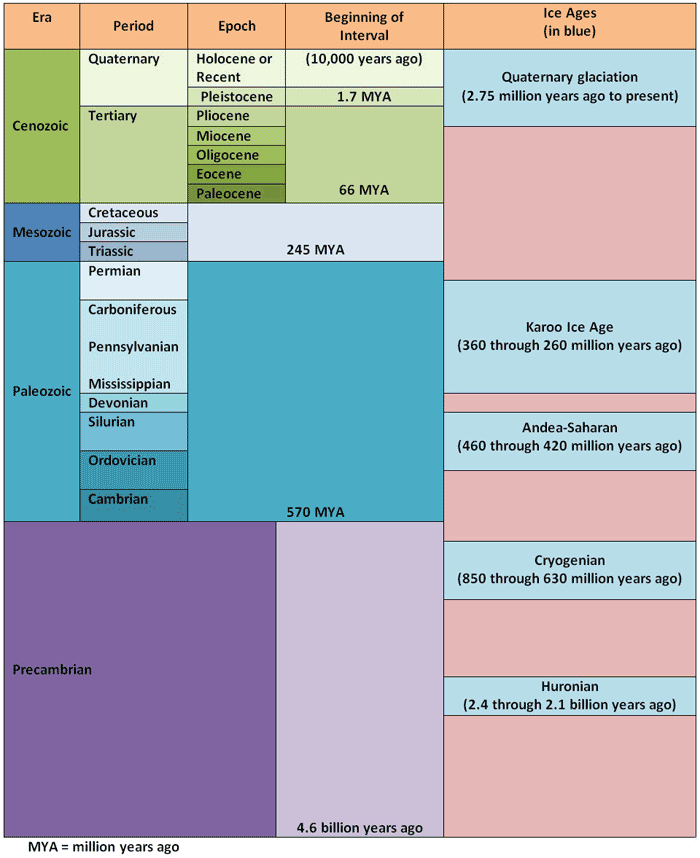Climates of the Past
Throughout much of Earth's geologic history, the global mean temperature was between 8°C and 15°C warmer than it is today with polar areas free of ice. These relatively warm periods were interrupted by cooler periods, referred to as ice ages. A decrease in average global temperature of 5°C may be enough start an ice age. The term “ice age” is misleading –– an “ice age” is actually a long period of climatic cooling, during which continents have repeated glaciations (glacial periods) interspersed with interglacial periods. During a glacial period, continental ice sheets, polar ice sheets and alpine glaciers are present or expand, sometimes covering as much as 30% of the continental landmasses. During an interglacial period, the climate is warmer and glaciers melt and retreat, and ice may cover less than 10% of Earth's land surfaces. During an ice age, climate fluctuates between glacial periods lasting tens of thousands of years and shorter interglacial periods.
Several ice ages have occurred over Earth's geologic history, and there is evidence of at least five major ice ages over the past 4.6 billion years. The following table shows Earth's generalized climatic history.

During the Precambrian and Paleozoic eras, four major ice ages occurred. The Mesozoic era spans from about 245 to 66 million years ago, and it is often called the “age of the dinosaurs.” This era was divided into three periods known as the Triassic, Jurassic, and the Cretaceous periods. During the Mesozoic era, there is no evidence of major glaciation, due in part to the large supercontinent, Pangaea, being located closer to the equatorial region of the planet. Some parts of Pangaea extended toward the South Pole but were still warm. As Pangaea split and the continents moved closer to their current positions, the climate remained warm. About 65 million years ago, there is evidence that a giant asteroid struck Earth. Scientists think that this event caused a mass extinction of the dinosaurs, who had dominated Earth for over 250 millions years, and other life forms.
During the late Paleocene epoch, Earth continued to warm. A huge amount of carbon dioxide flooded the ocean and atmosphere in possibly less than a span of 1,000 years, causing global average temperature to rise 5 to 9°C (9°to 16°F). This event is known as the Paleocene-Eocene Thermal Maximum (PETM). During this time, the ocean warmed and became more acidic. It is still unknown where all the carbon came from, but one idea is that methane hydrates, which are minerals in the ocean floor sediments, became unstable releasing a huge amount of methane into the water and atmosphere. In Module 2, you learned that methane is a major greenhouse gas.
Approximately 55 million years ago, Earth entered a long cooling trend due mostly to a decrease in the concentration of carbon dioxide in the atmosphere. (In Module X, you will learn more about other causes of major shifts in climate.)
The most recent ice age began about 2.75 million years ago. This marked the beginning of the Pleistocene epoch. This epoch is characterized by periods of glaciation and warmer periods or interglacial periods. Overall temperature dropped by 4°C (7.2°F) and Earth entered the glacial/interglacial sequence characteristic of the last 2.75 million years. The following figure shows the sequence of glacial and interglacial periods over the past 800,000 years. Therefore, at the present time, Earth is in an interglacial period within the most recent ice age. Often, when you hear someone refer to the ice age, they are referring to the most recent glacial period within the current ice age that began 2.75 million years ago.

Interglacial Periods over the last 800,000 years
You have probably heard that the planet is experiencing a warming trend, but as you have read, climate has fluctuated many times over Earth's long geologic history. So how do you know if this trend is actually happening and if so, how fast is it warming?
To learn more, proceed to the Investigation in the next section.
